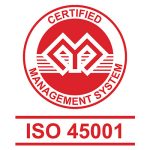ISO 45001 Occupational health and safety management system
 Organizations of all types are increasingly interested in achieving and demonstrating good performance in Occupational Health and Safety (OHS) by controlling risks, ensuring policy consistency, and meeting their OHS objectives. This interest is driven by ever-tightening legislation, the development of economic policies, and other measures that reinforce good OHS practices, as well as the growing concern expressed by stakeholders about OHS issues.
Organizations of all types are increasingly interested in achieving and demonstrating good performance in Occupational Health and Safety (OHS) by controlling risks, ensuring policy consistency, and meeting their OHS objectives. This interest is driven by ever-tightening legislation, the development of economic policies, and other measures that reinforce good OHS practices, as well as the growing concern expressed by stakeholders about OHS issues.
The ISO 45001 standard specifies the requirements for an Occupational Health and Safety (OHS) Management System and provides guidance on its implementation. This enables organizations to provide safe and healthy workplaces by preventing occupational injuries and illnesses and proactively improving their OHS performance. ISO 45001 is applicable to any organization, regardless of size, type of activity, complexity, or mode of operation, and is adaptable to various geographical, cultural, and social conditions.
The ISO 45001 standard helps an organization achieve the intended results of its OHS Management System. These intended results, consistent with the organization’s OHS policy, include:
- Continuous improvement of OHS performance
- Satisfaction of legal and other requirements
- Achievement of OHS goals
The requirements of the ISO 45001 standard are divided into 10 chapters, describing the organization’s operating framework, employee leadership and participation, planning, support, operation, performance evaluation, and improvement of the Occupational Health and Safety Management System.
Key requirements of the ISO 45001 standard include:
- Understanding the organization’s operating framework, the needs and expectations of employees and other stakeholders
- Leadership commitment to the effective implementation of the OHS management system
- Provision of necessary resources for planning and implementation by management
- Documented roles, responsibilities, and duties related to safety and health issues
- Existence of documented objectives and policies regarding safety and health
- Establishment and implementation of a process for employee consultation and participation in the health and safety system
- Identification, recording, and evaluation of risks within the organization (e.g., machinery, electricity, falls, chemicals) as well as risks and opportunities
- Identifying legal and other health and safety requirements and assessing compliance with them
- Personnel records proving the professional competence of workers, including training
- Internal and external communication processes
- Mandatory documented information demonstrating compliance with safety and health requirements
- Control of suppliers and subcontractors regarding safety and health
- Preparation of action plans and mock drills for emergency situations
- Investigation of dangerous incidents and documentation
- Scheduled management meetings with a mandatory agenda
- Internal audit of the OHS management system
- Recording and evaluating system non-conformances, taking corrective actions, and eliminating the causes of problems
The benefits of implementing a Health and Safety System at Work include:
- Improvement of the internal organization regarding health and safety matters
- Greater focus on achieving safety and health objectives
- Improvement of workplace infrastructure and safety conditions
- Enhanced safety and health performance and productivity
- Upgrading the organization’s image and reputation
- Identification of significant training needs and capacity building for staff, leading to more staff involvement in OHS improvements
- Increased human resource satisfaction and better working conditions
- Facilitation of cultural change within the organization
- Reduction of accidents and employee illnesses, thereby reducing operating costs
- Increased employee productivity due to improved working conditions
Certification of an organization’s Health and Safety System with the ISO 45001 standard can reduce risks and accidents in the long run. It also demonstrates the company’s commitment to prioritizing the health and safety of its employees.
